Conservation of a Child’s Boot
by Jacquie Jordan
Beginnings – First Impressions of a Buried Child’s Boot

The first subject of the year, Conservation Assessment and Treatment 2, has begun at the Grimwade Centre of Cultural Materials Conservation (GCCMC). This week, we selected and examined objects made of a variety of materials on which to conduct our major treatment projects with over the coming month. I chose a previously buried Child’s Shoe from the collection at the Bathurst District Historical Society (BDHS).

Upon first examination the child’s “shoe” is in fact a leather boot with leather laces. The boot is significantly damaged and in poor condition due to having been buried for a long period of time. The back section of the boot is missing, and the leather is brittle, crushed and distorted. I used a magnet to find that the exposed and rusted nails in the outsole were iron-based, and the green corrosion products on the lace eyelets indicate that they are a copper alloy (Selwyn 2004, see Figure 2 and 3).

The boot had a large amount of dirt and debris from burial, as well as a white cloudy bloom over one part of the upper leather and instep (See Figure 4). This could be mould, leeching oils, acids or salts from leather treatment, or salt that has come to the surface as a result of drying after excavation (English Heritage 2012; Kite & Thomson 2006). Under the microscope, this material appeared crystalline and waxy, and so is likely either of the latter two materials (see figure 5)(English Heritage 2012; Gottleib 1982). I plan to determine which of these it is through further analysis.

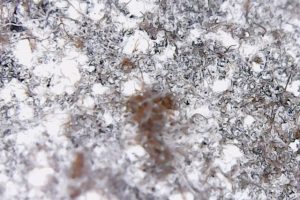
I had little information about the burial context of the boot. However, a suggestion was made by my supervisor about its possible association with the 19th century Colonial ritual of concealed garments (Evans 2010). This enhances the social, historical and potentially scientific significance embodied by the boot (ICOMOS 2013). The boot appears to be handmade, due to the inconsistent distribution of outsole nails, turnboot and vertical attachment design, indicating it may be from the correct era to be a deliberately concealed garment (Evans 2010; Veres 2005, p. 90). It was also found in a house demolition, further associating it as a concealment ritual (ibid).
I proposed a treatment that will stabilise the boot without removing evidence of burial, thereby retaining potential cultural values. This would include cleaning (and retention of material to enable future analysis), to remove dirt that could cause further damage to the boot. This will be followed by stabilisation of the metal components that are unstable and actively corroding, via inhibitors, consolidation and coating. And finally, humidification to regain some of the original shape of the boot to support future analysis of design and construction methods as well as improve visual interpretation (Kite & Thomson 2006; Veres 2005).
If this proposal is accepted by the custodians at the BDHS, i will then be able to discuss the burial context and establish the significance of the boot more thoroughly. This will, in turn, establish the basis for which material components, and their associated deterioration, should be preserved to adequately preserve the values embodied by the Child’s boot.
Decisions and Challenges – During Treatment of a Child’s Boot
I spent the past weeks examining, testing, preparing and beginning to implement the treatment I previously proposed for the preservation of the “Child’s Boot”. I have started down a treatment path keeping to the conservation tenet “do as much as necessary, and as little as possible” (Burra Charter 1999). In addition, I have considered the likely requirements and priorities of the custodians based on understanding the resources, goals and requirements of the BDHS (Lawler-Dormer 2017). That is, to have a collection that is stable for storage and display, in a condition that enables communication of its provenance, and appears well cared for.

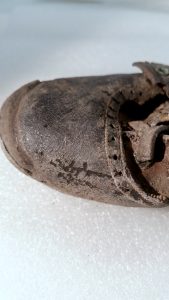
The first task was cleaning, an approaching of multiple stages with minimal intervention. The object was first brush vacuumed to remove surface dirt. Bamboo skewers, smoke sponges (a soft sponge eraser) and groom sticks ( a sticky natural rubber molecular trap) were used on the more robust areas to remove dirt and debris from burial. Microscopy, solubility testing, and spot testing on the white bloom over the left side of the boot showed that it contained some carbonates, other soluble salts (not chlorides or sulphates), and fatty acids (Odegaard et al 2000). The carbonates and other salts are likely due to exposure to water, soil and construction materials like plaster during burial (Kite & Thompson 2006). The fatty acids are likely to have previously been present in the leather matrix or part of a previous polish that have now come to the surface with fluctuations in temperature and relative humidity (RH)(ibid). This fatty component will not be physically or chemically harmful to the leather, but it is visually distracting and so was reduced with swabs of white spirits (see figure 6 and 7).
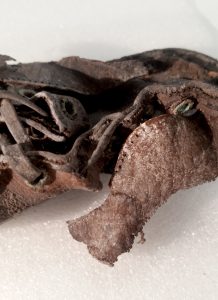
The salt efflorescence is primarily present inside pits and splits in the side of the leather sole, which is consistent with the presence of internal salts that have erupted to the surface and caused damage during a drying. It is likely that the boot will undergo future RH fluctuations that could continue the efflorescence cycle. Desalination was considered, which involves repeated bathing in water. Unfortunately due to the deteriorated state of the leather, this process could cause irreparable damage due to denaturation of the fibre and protein (Kite & Thompson 2006). Instead, I elected to remove the salts mechanically with a needle and stiff brush, followed by a “barely-wet” swab of de-ionised water (see figure 8).
Spot testing on the corroded eyelets and sole pins indicated that they were also lacking unstable compounds such as sulphates and carbonates (Odegaard et al 2000). However, the corrosion still posed an issue to the object’s aesthetics, can lead to structural instability and has the potential for re-activation in the future. In response to these problems, I mechanically reduced and inhibited the corrosion, followed by dewatering with acetone, and consolidation of both corrosion types with Paraloid B72 to prevent water ingress (see figures 8 and 9).
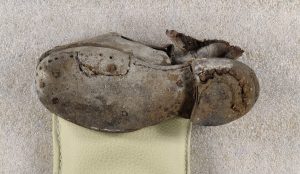
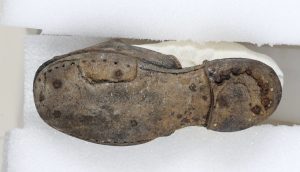
By addressing the two immediate issues of the white bloom and corrosion, the boot is now ready to progress to the next stage of treatment.
Final Steps and Conclusions – After Treatment of a Child’s Boot
In the past month, I have sought to balance a variety of factors to ethically treat the Child’s Boot. Some of these factors include use of available resources, cost, time management, sustainability, custodian input, and using treatment as a tool to assist the embodiment and communication of the object’s significant values. It has been a complex process, made difficult by the unavailability of the custodians during the treatment. As I have mentioned previously, this guided my treatment towards balancing minimal intervention with stabilisation and representation of the object’s form. This is most important to the final stage of treatment – reshaping.

The boot is extremely fragile, with brittle and flaking layers of leather, and a friable surface. This is worsened by the large areas of loss at the rear (see figure 11). While considering the issue of whether to reshape the boot, I thought about the stress to the leather caused by the creasing and cracks. It’s shape also made it difficult to interpret, which may increase handling. These factors increase the potential of physical damage to the boot, while the lack of understanding of the design and style damage the intangible appreciation of the form.

After much consideration, I decided to humidify and reshape the boot. Before I began, I knew that once flexible, the boot would need an internal support to hold it in the desired shape during drying, as well as in the future for storage and display. A small foam ‘foot’ was made to use as support (see figure 12).

I then placed the boot into a humidification chamber for several hours until it was pliable enough that I could slowly open it up and insert the form. During the drying process, I applied diluted Plextol B500 and Klucel G in Isopropanol as a consolidant to stabilise the friable and flaking components of the coating and leather. Once the boot had re-equilibrated with the ambient RH, I then inserted another ‘foot’ padded with Dacron and covered with a calico cotton fabric (see figure 13).
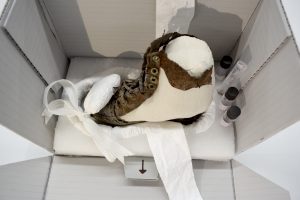
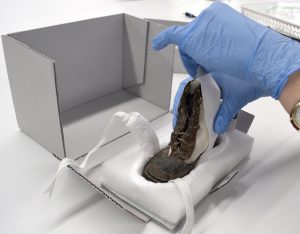
The treatment ended with rehousing, by which I ensured the boot could be handled and stored with a buffer against physical damage and environmental factors (see figures 14 & 15). While the boot remains vulnerable to damage from the salt and corrosion due to environmental changes, I have greatly improved its stability. It is now in a state that can be controlled by preventive measures such as monitoring and environmental control.
Acknowledgements
Many thanks to Dr Nicole Tse and Jenny Dickens for their guidance and assistance, to the students at GCCMC for support and to Bathurst District Historical Society for the opportunity to work on such an interesting object.
References
Australia ICOMOS, 2013, The Burra Charter: the Australia ICOMOS Charter for Places of Cultural Significance, 2013, and Practice Notes, viewed 8th February 2018, <http://australia.icomos.org/publications/burra-charter-practice-notes/>
Cameron, E Spriggs, J & Wills, B 2006, ‘Conservation of Archaeological Leather’ in Kite, M & Thomson, R (eds), Conservation of Leather and Related Materials, Butterworth– Heinemann, pp. 244-263
English Heritage, 2012, Waterlogged Organic Artefacts, English Heritage Publishing, Swindon, United Kingdom, viewed 8th February 2018, <https://content.historicengland.org.uk/images-books/publications/waterlogged-organic-artefacts/woa-guidelines.pdf/>
Evans, I 2010, Touching magic: deliberately concealed objects in old Australian houses and buildings, University of Newcastle, viewed 5th February 2018, <http://novaprd-lb.newcastle.edu.au:8080/vital/access/manager/Repository/uon:8218;jsessionid=A3CBF56855326CCDE69A45C2E5E349FE?exact=sm_creator%3A%22Evans%2C+Ian+Joseph%22>
Gottleib, 1982, A Note For Identifying Bloom on Leather Bindings”, JAIC, Volume 22, Number 1, Article 4, pp. 37 to 40, viewed 7th feb <http://cool.conservation-us.org/jaic/articles/jaic22-01-004.html>
Kite, M & Thomson, R (eds) 2006, Conservation of Leather and Related Materials, Butterworth– Heinemann, United Kingdom
Lawler-Dormer, K 2017, “Contributing to an Australian Conservation Resource Through Community Engagement and Consultation with the Users in Bathurst, NSW”, reCollections, Grimwade Centre for Cultural Materials Conservation, The University of Melbourne.
Odegaard, N Carroll, S and Zimmit, WS, 2000, Material Characterization Tests for Objects of Art and Archaeology, Archetype Publications, London
Selwyn, L 2004, Metals and corrosion: a handbook for the conservation professional, Canadian Conservation Institute (CCI), Ottawa
Smith, W 2003, Archaeological Conservation Using Polymers: Practical Applications for Organics Artifact Stabilisation, Texas A&M University Press
VERES, M 2005, “Introduction to the Analysis of Archaeological Footwear”, Australasian Historical Archaeology, vol. 23, pp. 89-96